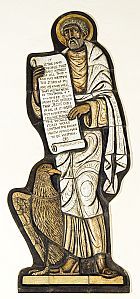
THE GOSPEL OF MATTHEW
The Empty Tomb: Mt 28,1-15
The characters in these scenes besides the women and the guards are the angel, Jesus himself and the chief priests and elders.
Both verses 2 and 9 begin "And behold" ("suddenly" in NRSV). The first part is therefore the encounter between the women and the angel (28,1-8) while the second part is their encounter with Jesus (28,9-10). The angel and Jesus give the same message to the women ("Go...", verses 7 and 10).
The third scene is then the very different encounter of the guards and the chief priests (28,11-15). This provides the contrast with the women. The women proclaim the truth, the guards tell lies.
Return to the main page.
The Two Women: 28,1-10
When we compare Matthew's account with that of Mark, we find that Matthew has only two women visiting the tomb. There is no mention of an anointing nor the question about who will roll back the stone (Mk 16,3). The cosmic upheavals are special to Matthew with the young man (Mk 16,5) becoming an angel. Most importantly, Matthew has given a new orientation to Mark. No longer are the women running away with fear (Mk 16,8) but rather with joy (verse 8).
Matthew states that the women visit the tomb after the sabbath which would have ended at sunset. With the evangelists, Matthew then makes the point in 28,1 that the women visit the following morning just as darkness becomes light. John is clearest about this with the comment that was still dark (Jn 20,1).
Earthquakes as can be seen in the Old Testament (Exodus 19,18 or 1 Kings 19,11 for example) are a sign of God's presence and involvement. The earthquake occurs therefore at the two crucial stages of Jesus' death (27,51) and his rising from the dead (28,2).
The description of the angel's clothing makes him very similar to God himself - as was the description of Jesus at his Transfiguration (Mt 17,2). The book of Daniel uses similar terms.
In verse 4, Matthew speaks of "the watchers" rather than "the guards" as in the translations. They become like dead men in their fear, they are not open to life.
The women by contrast (verse 8) become full of life with their joy. Their fear is a divine awe as in the Old Testament because they have heard the angel's proclamation (verses 6 and 7). This is the basic Christian proclamation, similar to Jesus' three predictions of his fate, 20,17-19 being the third and most detailed.
The women then meet Jesus in the second part 28,9-10. What is striking here is that there is no special description of Jesus like that of the angel and he is called by his name. Matthew here wishes to stress the continuity with the Jesus the women had known. John wishes instead to bring out the discontinuity when Jesus forbids Mary Magdalene to touch him (Jn 20,17).
Jesus' message to the women in verse 10 is the same as the angel's message in verse 7. Like Mary Magdalene in John's Gospel, the women therefore become the first witnesses to the resurrection to the disciples. Whereas in verse 7, the angel called them disciples, in verse 10 Jesus calls them brothers (even in the NRSV). Reconciliation (26,56) is assumed.
The Guards, 28,11-15
The guards now make their report not to Pilate but to the chief priests in verse 11. As with Judas, so now with the guard. In verse 12 the chief priests resort to money to solve their problem.
Verse 13 may be the heart of the matter between Christians and Jews: was the body of Jesus stolen or did he rise from the dead. These verses offer us a classic cover-up even though the guards, now clearly soldiers of the governor, have to admit to being asleep on duty.
Verse 15 gives us the background to this tale of the guards; disputes between Christians and Jews at the time when the evangelist was writing. Both sides however accept that the tomb is now empty.
Let us now return to the main page.
